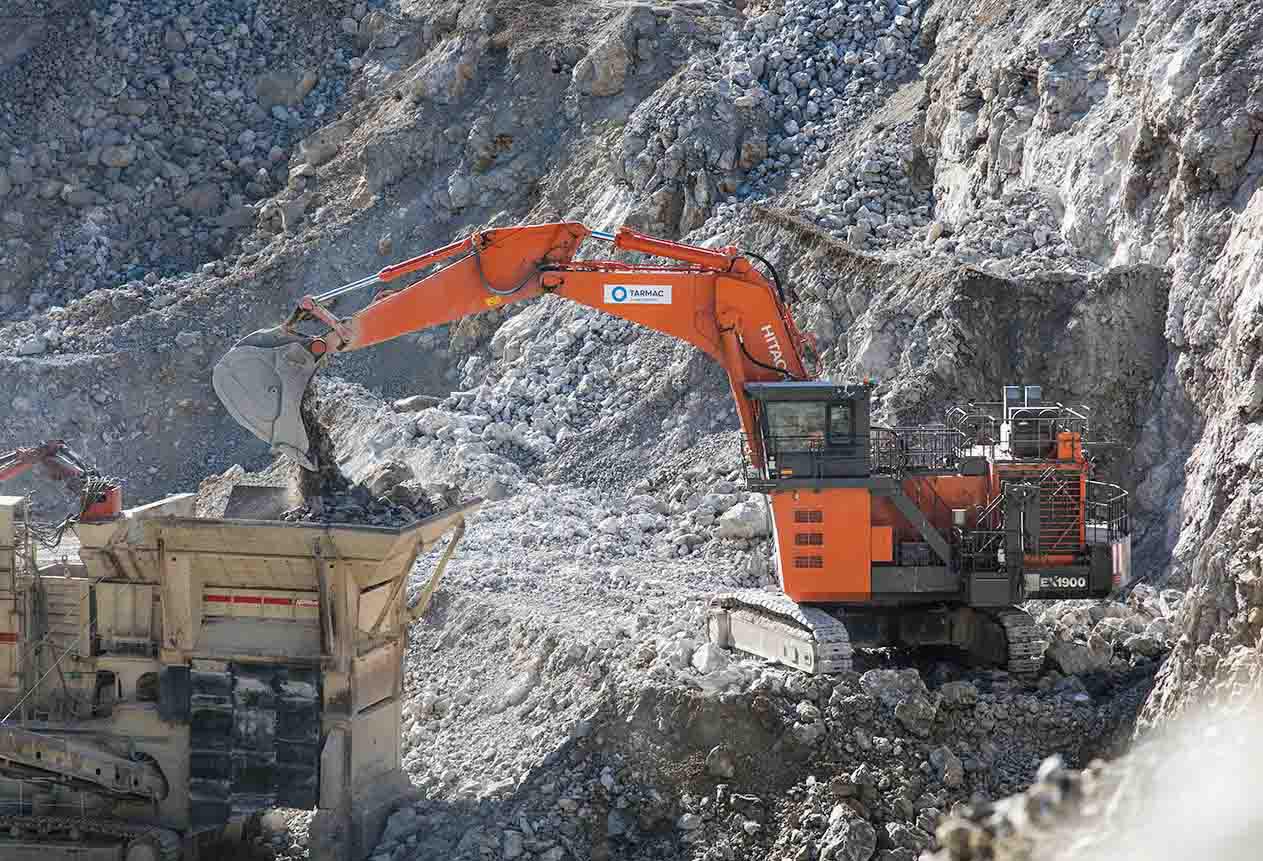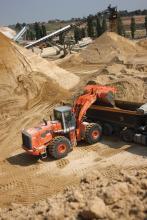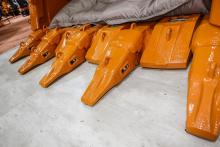Materials supplier Tarmac has invested in a Hitachi EX1900-6 ultra-large excavator for its Swinden Quarry in North Yorkshire, England.
The EX1900-6 is used to load up to 1,200 tonnes of carboniferous limestone per hour directly into a 200tonne mobile crusher. A field conveyor takes the material to a secondary crusher at an average rate of 1,000tonnes/hour.
The Hitachi model was supplied with a longer boom and arm, and a smaller 8m³ bucket, customary on a machine of this size. “This is because it needs

Hitachi EX1900-6 ultra-large excavator in Yorkshire
Materials supplier Tarmac has invested in a Hitachi EX1900-6 ultra-large excavator for its Swinden Quarry in North Yorkshire, England.
The EX1900-6 is used to load up to 1,200 tonnes of carboniferous limestone per hour directly into a 200tonne mobile crusher. A field conveyor takes the material to a secondary crusher at an average rate of 1,000tonnes/hour.
The233 Hitachi model was supplied with a longer boom and arm, and a smaller 8m³ bucket, customary on a machine of this size. “This is because it needs a larger working range to reach the limestone and load the crusher,” said Mark Turnham, mines and quarries manager at Hitachi Construction Machinery (UK).
“It means the primary crusher doesn’t need to be moved as frequently. This can take 45 minutes, so it enhances the efficiency of the process.”
The ultra-large excavator was also supplied with Hitachi Genuine Ground Engaging Tools, which HCM said further enhance productivity by improving penetration and overall digging power. The edge shrouds for the bucket and long penetration teeth are manufactured from high-grade steel and tested to the same standard as all Hitachi construction equipment.
Swinden Quarry produces various sizes of aggregates, from 100mm down to dust - including grades of 80, 40, 28, 20, 14, 10 and 6 - which are dry stored in silos. The material is either transferred directly to the site’s rail siding via conveyor to the fully-automated truck load-out, or into the ‘toast rack’ storage, from which a wheeled loader directly loads customers’ trucks.
Around 60% of the materials are transported 60km by rail to2399 Tarmac’s dry distribution centres in Leeds, for onward transportation to South Yorkshire, and a depot in Hull, nearly 100km away. Much of the limestone is used in Tarmac’s concrete and asphalt plants in the north of England.
With the arrival of the EX1900-6, Tarmac intends to maintain production levels and annual output of 2.3 million tonnes. “During the tender process, we looked at productivity and fuel consumption,” said quarry manager Jez West. “We wanted to reduce operational hours by increasing productivity.”
Operator George Metcalf, who has worked around the machine since its delivery in November, said that the speed and productivity is faster than other machines he has used. “There is also good all-round visibility. The cab feels more open and spacious, the seat is comfortable and the controls are easy to use.”
The EX1900-6 is used to load up to 1,200 tonnes of carboniferous limestone per hour directly into a 200tonne mobile crusher. A field conveyor takes the material to a secondary crusher at an average rate of 1,000tonnes/hour.
The
“It means the primary crusher doesn’t need to be moved as frequently. This can take 45 minutes, so it enhances the efficiency of the process.”
The ultra-large excavator was also supplied with Hitachi Genuine Ground Engaging Tools, which HCM said further enhance productivity by improving penetration and overall digging power. The edge shrouds for the bucket and long penetration teeth are manufactured from high-grade steel and tested to the same standard as all Hitachi construction equipment.
Swinden Quarry produces various sizes of aggregates, from 100mm down to dust - including grades of 80, 40, 28, 20, 14, 10 and 6 - which are dry stored in silos. The material is either transferred directly to the site’s rail siding via conveyor to the fully-automated truck load-out, or into the ‘toast rack’ storage, from which a wheeled loader directly loads customers’ trucks.
Around 60% of the materials are transported 60km by rail to
With the arrival of the EX1900-6, Tarmac intends to maintain production levels and annual output of 2.3 million tonnes. “During the tender process, we looked at productivity and fuel consumption,” said quarry manager Jez West. “We wanted to reduce operational hours by increasing productivity.”
Operator George Metcalf, who has worked around the machine since its delivery in November, said that the speed and productivity is faster than other machines he has used. “There is also good all-round visibility. The cab feels more open and spacious, the seat is comfortable and the controls are easy to use.”







